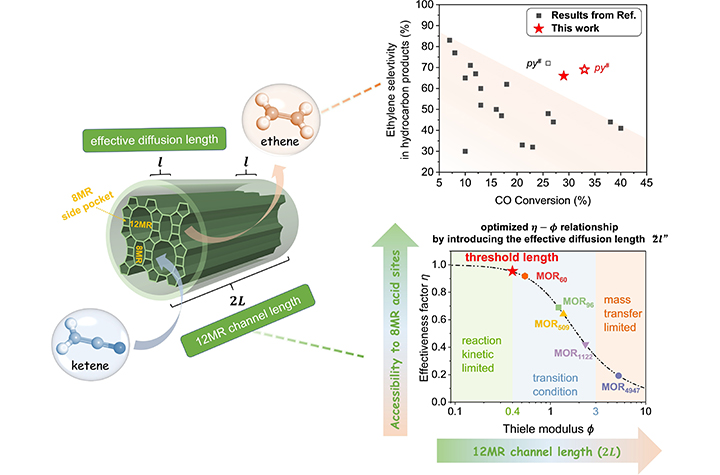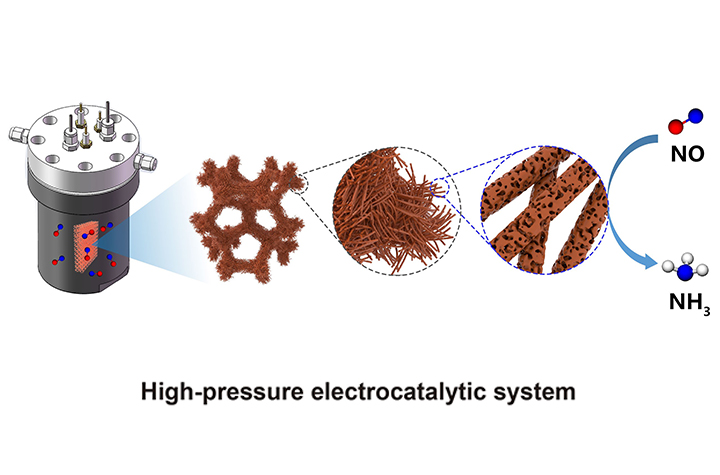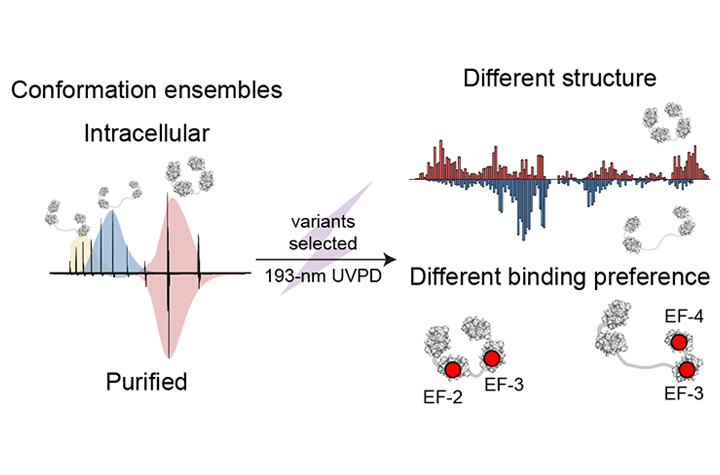Research News
-
 03 11, 2025Researchers Develop Chainmail Integrated-electrode for Highly Efficient Hydrogen Sulfide ElectrolysisResearchers developed a dual-level chainmail integrated-electrode that enables highly efficient hydrogen production via H2S electrolysis.Hydrogen sulfide (H2S), a toxic and corrosive byproduct of fossil fuel extraction, poses significant environmental and industrial challenges. While the conventional Claus process converts H2S into elemental sulfur, it fails to recover hydrogen gas, missing an opportunity for sustainable energy production.Electrocatalytic H2S decomposition offers a promising strategy to simultaneously eliminating pollutants and producing green hydrogen. However, the acidic nature of H2S deactivates non-precious metal catalysts and degrades electrode structures, making it difficult to achieve both high efficiency and long-term stability.Efficient H2S electrolysis to H2 production in the flow-cell device using chainmail integrated-electrode (Image by ZHANG Mo)In a study published in Angew. Chem. Int. Ed., a research group led by Prof. DENG Dehui and Assoc. Prof. CUI Xiaoju from the Dalian Institute of Chemical Physics (DICP) of the Chinese Academy of Sciences (CAS) has developed a dual-level chainmail integrated-electrode that enables highly efficient hydrogen production via H2S electrolysis.Researchers designed a graphene encapsulating nickel foam (Ni@NC foam) electrode with a dual-level chainmail structure, enhancing both catalytic activity and durability. This electrode achieved an industrial-scale current density exceeding 1 A/cm2 at 1.12 V versus the reversible hydrogen electrode, which was five times higher than commercial nickel foam electrodes. Moreover, the Ni@NC foam electrode remained stable for over 300 hours, demonstrating a lifespan at least ten times longer than commercial nickel foam electrodes.In a simulated natural gas desulfurization test, the chainmail integrated-electrode completely oxidized and removed 20% H2S at the anode, producing sulfur powder simultaneously. Meanwhile, high-purity hydrogen was collected at the cathode. Compared with conventional water electrolysis, the system reduced energy consumption by 43% at the current density of 200 mA/cm², offering a more sustainable approach to hydrogen production."Our study provides an efficient, low-energy solution for natural gas purification and opens up the potential of converting H2S into valuable hydrogen fuel for industrial applications," said Prof. DENG.
03 11, 2025Researchers Develop Chainmail Integrated-electrode for Highly Efficient Hydrogen Sulfide ElectrolysisResearchers developed a dual-level chainmail integrated-electrode that enables highly efficient hydrogen production via H2S electrolysis.Hydrogen sulfide (H2S), a toxic and corrosive byproduct of fossil fuel extraction, poses significant environmental and industrial challenges. While the conventional Claus process converts H2S into elemental sulfur, it fails to recover hydrogen gas, missing an opportunity for sustainable energy production.Electrocatalytic H2S decomposition offers a promising strategy to simultaneously eliminating pollutants and producing green hydrogen. However, the acidic nature of H2S deactivates non-precious metal catalysts and degrades electrode structures, making it difficult to achieve both high efficiency and long-term stability.Efficient H2S electrolysis to H2 production in the flow-cell device using chainmail integrated-electrode (Image by ZHANG Mo)In a study published in Angew. Chem. Int. Ed., a research group led by Prof. DENG Dehui and Assoc. Prof. CUI Xiaoju from the Dalian Institute of Chemical Physics (DICP) of the Chinese Academy of Sciences (CAS) has developed a dual-level chainmail integrated-electrode that enables highly efficient hydrogen production via H2S electrolysis.Researchers designed a graphene encapsulating nickel foam (Ni@NC foam) electrode with a dual-level chainmail structure, enhancing both catalytic activity and durability. This electrode achieved an industrial-scale current density exceeding 1 A/cm2 at 1.12 V versus the reversible hydrogen electrode, which was five times higher than commercial nickel foam electrodes. Moreover, the Ni@NC foam electrode remained stable for over 300 hours, demonstrating a lifespan at least ten times longer than commercial nickel foam electrodes.In a simulated natural gas desulfurization test, the chainmail integrated-electrode completely oxidized and removed 20% H2S at the anode, producing sulfur powder simultaneously. Meanwhile, high-purity hydrogen was collected at the cathode. Compared with conventional water electrolysis, the system reduced energy consumption by 43% at the current density of 200 mA/cm², offering a more sustainable approach to hydrogen production."Our study provides an efficient, low-energy solution for natural gas purification and opens up the potential of converting H2S into valuable hydrogen fuel for industrial applications," said Prof. DENG. -
 03 10, 2025Researchers Reveal the Role of Zeolite Acid Site Accessibility in Syngas ConversionResearchers revealed how the accessibility of zeolite acid site plays a crucial role in determining syngas conversion performance.Zeolites and zeotypes are widely used in the energy and chemical industries due to their unique pore structures and excellent shape-selective catalytic properties. However, these inherent advantages also lead to diffusion limitations, preventing guest molecules from effectively accessing internal active sites and thereby hindering catalytic efficiency.Schematic illustration of structure–mass transfer–activity relationships (Image by WANG Haodi)In a study published in Angewandte Chemie International Edition (VIP paper), a research group led by Prof. JIAO Feng and Prof. PAN Xiulian from the Dalian Institute of Chemical Physics (DICP) of the Chinese Academy of Sciences (CAS) has revealed how the accessibility of zeolite acid site plays a crucial role in determining syngas conversion performance.Using mordenite (MOR) zeolite as a model catalyst, researchers investigated its unique pore structure, where acid sites within the 8-membered ring (8MR) side pockets serve as active sites for syngas-to-ethylene via OXZEO, while the 12-membered ring (12MR) channels act as molecular transport pathways.By systematically analyzing the mass transfer effects of MOR catalysts with varying 12MR channel lengths (2L), the researchers established a quantitative relationship between active sites accessibility and catalytic performance.Moreover, researchers identified 60 nm as the critical threshold for the 12MR channel length, where the reaction approached kinetic limitation. Using this property, they optimized the ZnAlOx-MOR bifunctional catalyst, achieving a CO conversion of 33% and an ethylene selectivity of 69%."Our study provides new insights into mass transfer mechanisms inside zeolites and offers a framework for designing high-performance zeolite-based catalysts," said Prof. JIAO.
03 10, 2025Researchers Reveal the Role of Zeolite Acid Site Accessibility in Syngas ConversionResearchers revealed how the accessibility of zeolite acid site plays a crucial role in determining syngas conversion performance.Zeolites and zeotypes are widely used in the energy and chemical industries due to their unique pore structures and excellent shape-selective catalytic properties. However, these inherent advantages also lead to diffusion limitations, preventing guest molecules from effectively accessing internal active sites and thereby hindering catalytic efficiency.Schematic illustration of structure–mass transfer–activity relationships (Image by WANG Haodi)In a study published in Angewandte Chemie International Edition (VIP paper), a research group led by Prof. JIAO Feng and Prof. PAN Xiulian from the Dalian Institute of Chemical Physics (DICP) of the Chinese Academy of Sciences (CAS) has revealed how the accessibility of zeolite acid site plays a crucial role in determining syngas conversion performance.Using mordenite (MOR) zeolite as a model catalyst, researchers investigated its unique pore structure, where acid sites within the 8-membered ring (8MR) side pockets serve as active sites for syngas-to-ethylene via OXZEO, while the 12-membered ring (12MR) channels act as molecular transport pathways.By systematically analyzing the mass transfer effects of MOR catalysts with varying 12MR channel lengths (2L), the researchers established a quantitative relationship between active sites accessibility and catalytic performance.Moreover, researchers identified 60 nm as the critical threshold for the 12MR channel length, where the reaction approached kinetic limitation. Using this property, they optimized the ZnAlOx-MOR bifunctional catalyst, achieving a CO conversion of 33% and an ethylene selectivity of 69%."Our study provides new insights into mass transfer mechanisms inside zeolites and offers a framework for designing high-performance zeolite-based catalysts," said Prof. JIAO. -
 02 21, 2025DNL-17: Novel Small-pore Aluminophosphate Molecular SieveResearchers synthesized a novel small-pore AlPO MS, named DNL-17, using a flexible diquaternary ammonium compound as organic structure-directing agent (OSDA).Aluminophosphate (AlPO) molecular sieves (MSs) are crystalline microporous materials made from alternating PO₄ tetrahedra and AlO₄ tetrahedra, forming ordered channel systems and cage-like structures.Small-pore AlPO MSs with three-dimensional (3D) channel systems are particularly promising for selective adsorption and energy storage. However, it remains a challenge to synthesize and determine their crystallographic structures.In a study published in Journal of the American Chemical Society, a research group led by Prof. GUO Peng and Prof. LIU Zhongmin from the Dalian Institute of Chemical Physics (DICP) of the Chinese Academy of Sciences (CAS) synthesized a novel small-pore AlPO MS, named DNL-17, using a flexible diquaternary ammonium compound as organic structure-directing agent (OSDA).Design, synthesis, and structural analysis of DNL-17 (Image by NIE Chenyang)Researchers used cutting-edge 3D electron diffraction (ED) technology to directly determine the complex crystallographic structure of DNL-17. This new member of the ABC-6 family features 3D 8 * 8 * 8-ring pores and a framework structure containingfour characteristic cages (d6r, can, eri, and cha), with a distinct 24-layer stacking sequence along the c axis (AABAACAABBCBBABBCCACCBCC).In addition, researchers identified a unique structure-directing effect in which the flexible OSDAs adopt various conformations to stabilize different cages during crystallization. They also demonstrated that DNL-17 shows promise for selective adsorption in the separation of n-butane and isobutane."This study demonstrates that OSDAs can construct novel AlPO MSs through different conformations, paving the way for the design and synthesis of new molecular sieves," said Prof. GUO.
02 21, 2025DNL-17: Novel Small-pore Aluminophosphate Molecular SieveResearchers synthesized a novel small-pore AlPO MS, named DNL-17, using a flexible diquaternary ammonium compound as organic structure-directing agent (OSDA).Aluminophosphate (AlPO) molecular sieves (MSs) are crystalline microporous materials made from alternating PO₄ tetrahedra and AlO₄ tetrahedra, forming ordered channel systems and cage-like structures.Small-pore AlPO MSs with three-dimensional (3D) channel systems are particularly promising for selective adsorption and energy storage. However, it remains a challenge to synthesize and determine their crystallographic structures.In a study published in Journal of the American Chemical Society, a research group led by Prof. GUO Peng and Prof. LIU Zhongmin from the Dalian Institute of Chemical Physics (DICP) of the Chinese Academy of Sciences (CAS) synthesized a novel small-pore AlPO MS, named DNL-17, using a flexible diquaternary ammonium compound as organic structure-directing agent (OSDA).Design, synthesis, and structural analysis of DNL-17 (Image by NIE Chenyang)Researchers used cutting-edge 3D electron diffraction (ED) technology to directly determine the complex crystallographic structure of DNL-17. This new member of the ABC-6 family features 3D 8 * 8 * 8-ring pores and a framework structure containingfour characteristic cages (d6r, can, eri, and cha), with a distinct 24-layer stacking sequence along the c axis (AABAACAABBCBBABBCCACCBCC).In addition, researchers identified a unique structure-directing effect in which the flexible OSDAs adopt various conformations to stabilize different cages during crystallization. They also demonstrated that DNL-17 shows promise for selective adsorption in the separation of n-butane and isobutane."This study demonstrates that OSDAs can construct novel AlPO MSs through different conformations, paving the way for the design and synthesis of new molecular sieves," said Prof. GUO. -
 02 20, 2025
02 20, 2025Novel Bifacial Linker Developed to Prevent Heterointerfacial Delamination in Flexible Perovskite Solar Cells
Researchers developed a novel bifacial linker to prevent heterointerfacial delamination in flexible perovskite solar cells.Flexible perovskite solar cells (F-PSCs) have attracted attention for their potential in diverse applications. However, their commercialization is hindered by challenges related to low mechanical flexibility, which leads to poor adhesion between the perovskite absorber layer and the flexible substrate.A recent study published in Advanced Materials offers a promising solution to this problem with the development of a novel bifacial linker designed to prevent heterointerfacial delamination in F-PSCs. This study was conducted by Prof. YANG Dong and Prof. LIU Shengzhong from the Dalian Institute of Chemical Physics (DICP) of the Chinese Academy of Sciences (CAS).Schematic illustration demonstrating the experimental validation of robust heterointerfacial adhesion between perovskite and SnO2 with the addition of the bifacial linker BnBF3K (Image by YANG Shaoan and ZHU Xuejie)Researchers introduced a novel bifacial linker, potassium benzyl(trifluoro)borate (BnBF3K), to enhance the adhesion at the SnO2/perovskite interface, which effectively addreses the delamination issue in F-PSCs. By optimizing heterointerfacial delamination, minimizing buried defects in the perovskite, reducing SnO2 surface defects, and improving physical contact between the perovskite and the SnO2-coated substrate, they were able to significantly enhance the performance of the solar cells.Further analysis confirmed the crucial role of the bifacial linker in boosting device performance. The unique properties of BnBF3K facilitated strong molecular interactions and robust adsorption, ensuring excellent adhesion between the perovskite and the SnO2 substrate. The strengthened mechanical interface provided a stable foundation for electrical contact, allowing efficient charge extraction and transport, even under mechanical deformation of the flexible device.As a result of the bifacial linker, the researchers achieved an efficiency of 21.82% (certified at 21.39%) for a flexible perovskite solar module with an area of 12.80 cm2. Moreover, the flexible modules demonstrated excellent mechanical flexibility, retaining 96.56% of their initial efficiency after 6,000 bending cycles, highlighting their potential for a wide range of practical applications."Our study not only improves the mechanical stability of flexible perovskite devices but also reduces buried surface defects and optimizes energy level alignment," said Prof. LIU. -
 02 19, 2025Researchers Achieve Electrosynthesis of Ammonia from NO in Pressurized ElectrolyzerResearchers have developed a sustainable electrosynthesis method for ammonia from nitric oxide, achieving ampere-level current density in a pressurized electrolyzer.Electrocatalytic nitric oxide reduction reaction (NORR) offers a promising route for sustainable ammonia (NH3) synthesis and for removing NO pollutants. However, achieving NH3 production from NO with ampere-level current density and long-term stability remains a challenge for industrial applications.One major obstacle is the poor solubility of NO in water, combined with the undesirable hydrogen evolution reaction (HER), which limits the efficiency and durability of NH3 production on an industrial scale.Schematic illustration of the high-pressure electrocatalytic system featuring a pressurized electrolyzer paired with a hierarchical porous Cu nanowire array (Cu NWA) monolithic electrode and the comparison of NORR activity under different NO pressure (Image by YANG Wenqiang and LIU Huan)In a study published in Nature Communications, a research group led by Prof. DENG Dehui, Assoc. Prof. CUI Xiaoju, and Prof. YU Liang from the Dalian Institute of Chemical Physics (DICP) of the Chinese Academy of Sciences (CAS) developed a sustainable electrosynthesis method for NH3 from NO, achieving ampere-level current density in a pressurized electrolyzer.Researchers used an in situ-grown hierarchical porous copper nanowire array (Cu NWA) monolithic electrode to regulate the kinetics and thermodynamics of the NORR. They achieved a NH3 partial current density of 1007 mA cm–2, a Faradaic efficiency of 96.1%, and an NH3 yield rate of 10.5 mmol h–1 cm–2, remaining stable at 1000 mA cm–2 for over 100 hours, demonstrating great potential for industrial-scale applications.The high NORR performance was revealed to benefit from the in situ-formed hierarchical porous structure of the Cu NWA electrode. This structure maximized the exposure of Cu active sites, enhancing internal mass transfer. The high-pressure environment within the electrolyzer also enhanced NO solvation and external mass transfer, thereby promoting NO adsorption onto the Cu surface. Moreover, the high NO coverage destabilized the adsorbed NO and weakened hydrogen adsorption, facilitating efficient NO hydrogenation to NH3 while simultaneously suppressing the HER."Our study provides a new way for the industrial electrosynthesis of ammonia and the efficient catalytic conversion of inert small molecules," said Prof. DENG.
02 19, 2025Researchers Achieve Electrosynthesis of Ammonia from NO in Pressurized ElectrolyzerResearchers have developed a sustainable electrosynthesis method for ammonia from nitric oxide, achieving ampere-level current density in a pressurized electrolyzer.Electrocatalytic nitric oxide reduction reaction (NORR) offers a promising route for sustainable ammonia (NH3) synthesis and for removing NO pollutants. However, achieving NH3 production from NO with ampere-level current density and long-term stability remains a challenge for industrial applications.One major obstacle is the poor solubility of NO in water, combined with the undesirable hydrogen evolution reaction (HER), which limits the efficiency and durability of NH3 production on an industrial scale.Schematic illustration of the high-pressure electrocatalytic system featuring a pressurized electrolyzer paired with a hierarchical porous Cu nanowire array (Cu NWA) monolithic electrode and the comparison of NORR activity under different NO pressure (Image by YANG Wenqiang and LIU Huan)In a study published in Nature Communications, a research group led by Prof. DENG Dehui, Assoc. Prof. CUI Xiaoju, and Prof. YU Liang from the Dalian Institute of Chemical Physics (DICP) of the Chinese Academy of Sciences (CAS) developed a sustainable electrosynthesis method for NH3 from NO, achieving ampere-level current density in a pressurized electrolyzer.Researchers used an in situ-grown hierarchical porous copper nanowire array (Cu NWA) monolithic electrode to regulate the kinetics and thermodynamics of the NORR. They achieved a NH3 partial current density of 1007 mA cm–2, a Faradaic efficiency of 96.1%, and an NH3 yield rate of 10.5 mmol h–1 cm–2, remaining stable at 1000 mA cm–2 for over 100 hours, demonstrating great potential for industrial-scale applications.The high NORR performance was revealed to benefit from the in situ-formed hierarchical porous structure of the Cu NWA electrode. This structure maximized the exposure of Cu active sites, enhancing internal mass transfer. The high-pressure environment within the electrolyzer also enhanced NO solvation and external mass transfer, thereby promoting NO adsorption onto the Cu surface. Moreover, the high NO coverage destabilized the adsorbed NO and weakened hydrogen adsorption, facilitating efficient NO hydrogenation to NH3 while simultaneously suppressing the HER."Our study provides a new way for the industrial electrosynthesis of ammonia and the efficient catalytic conversion of inert small molecules," said Prof. DENG. -
 02 18, 2025Researchers Develop New In-Cell Ultraviolet Photodissociation Top-Down Mass Spectrometry MethodResearchers developed a new method for in-cell characterization of proteins using vaccumultraviolet photodissociationtop-down mass spectrometry (UVPD-TDMS). This method provided an innovative technology for analyzing the heterogeneity of intracellular protein in situ with mass spectrometry (MS).Proteins in cells are highly flexible and often exist in multiple conformations, each with unique abilities to bind ligands. These conformations are regulated by the organism to control protein function.Currently, most studies on protein structure and activity are conducted using purified proteins in vitro, which cannot fully replicate the complex of the intracellular environment and maybe influenced by the purification process or buffer conditions.In a study published in the Journal of the American Chemical Society, a research team led by Prof. WANG Fangjun from the Dalian Institute of Chemical Physics (DICP) of the Chinese Academy of Sciences (CAS), in collaboration with Prof. HUANG Guangming from the University of Science and Technology of China, developed a new method for in-cell characterization of proteins using vaccumultraviolet photodissociationtop-down mass spectrometry (UVPD-TDMS). This method provided an innovative technology for analyzing the heterogeneity of intracellular protein in situ with mass spectrometry (MS).The team combined in-cell MS with 193-nm UVPD to directly analyze protein structures within cells. This method first employed induced electrospray ionization, which ionizes intracellular proteins with minimal structural perturbation. The charge state distributions of intracellular proteins were then analyzed to determine their conformational ensembles. UVPD was subsequently applied to excite and dissociate protein backbones, generating abundant a-, b-, c-, x-, y-, and z-fragment ions, which are rich in protein structure and interaction features.The team applied this new method to directly ionize and detect highly expressed calmodulin (CaM) from E.coli cells using induced electrospray ionization (iESI). They discovered that intracellular CaM existed in three main coexisting conformations, with the extended conformation being significantly more abundant than the form found in purified CaM.Furthermore, the team employed UVPD-TDMS to study the binding forms and structural characteristics of different Ca2+-binding variants of CaM. They found that the ability of CaM to bind Ca2+ was regulated by conformation-dependent, with the compact conformation showing a higher affinity for Ca2+ than the extended form. Additionally, the team revealed that the first two Ca2+ ions preferentially bind to EF-2 and EF-3 in the compact conformation, while the extended form favors binding to EF-3 and EF-4 in the C-lobe of the protein. "Our study introduces a novel concept for in-cell protein characterization," said Prof. WANG. "By precisely selecting the mass and charge distribution, in-cell UVPD-TDMS enables detailed characterization of intracellular protein variants and conformation, and this method has been successfully demonstrated in the analysis of protein heterogeneity," Prof. WANG added.<!--!doctype-->
02 18, 2025Researchers Develop New In-Cell Ultraviolet Photodissociation Top-Down Mass Spectrometry MethodResearchers developed a new method for in-cell characterization of proteins using vaccumultraviolet photodissociationtop-down mass spectrometry (UVPD-TDMS). This method provided an innovative technology for analyzing the heterogeneity of intracellular protein in situ with mass spectrometry (MS).Proteins in cells are highly flexible and often exist in multiple conformations, each with unique abilities to bind ligands. These conformations are regulated by the organism to control protein function.Currently, most studies on protein structure and activity are conducted using purified proteins in vitro, which cannot fully replicate the complex of the intracellular environment and maybe influenced by the purification process or buffer conditions.In a study published in the Journal of the American Chemical Society, a research team led by Prof. WANG Fangjun from the Dalian Institute of Chemical Physics (DICP) of the Chinese Academy of Sciences (CAS), in collaboration with Prof. HUANG Guangming from the University of Science and Technology of China, developed a new method for in-cell characterization of proteins using vaccumultraviolet photodissociationtop-down mass spectrometry (UVPD-TDMS). This method provided an innovative technology for analyzing the heterogeneity of intracellular protein in situ with mass spectrometry (MS).The team combined in-cell MS with 193-nm UVPD to directly analyze protein structures within cells. This method first employed induced electrospray ionization, which ionizes intracellular proteins with minimal structural perturbation. The charge state distributions of intracellular proteins were then analyzed to determine their conformational ensembles. UVPD was subsequently applied to excite and dissociate protein backbones, generating abundant a-, b-, c-, x-, y-, and z-fragment ions, which are rich in protein structure and interaction features.The team applied this new method to directly ionize and detect highly expressed calmodulin (CaM) from E.coli cells using induced electrospray ionization (iESI). They discovered that intracellular CaM existed in three main coexisting conformations, with the extended conformation being significantly more abundant than the form found in purified CaM.Furthermore, the team employed UVPD-TDMS to study the binding forms and structural characteristics of different Ca2+-binding variants of CaM. They found that the ability of CaM to bind Ca2+ was regulated by conformation-dependent, with the compact conformation showing a higher affinity for Ca2+ than the extended form. Additionally, the team revealed that the first two Ca2+ ions preferentially bind to EF-2 and EF-3 in the compact conformation, while the extended form favors binding to EF-3 and EF-4 in the C-lobe of the protein. "Our study introduces a novel concept for in-cell protein characterization," said Prof. WANG. "By precisely selecting the mass and charge distribution, in-cell UVPD-TDMS enables detailed characterization of intracellular protein variants and conformation, and this method has been successfully demonstrated in the analysis of protein heterogeneity," Prof. WANG added.<!--!doctype-->